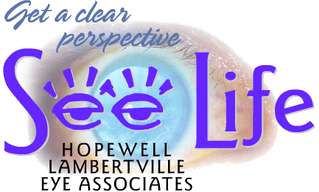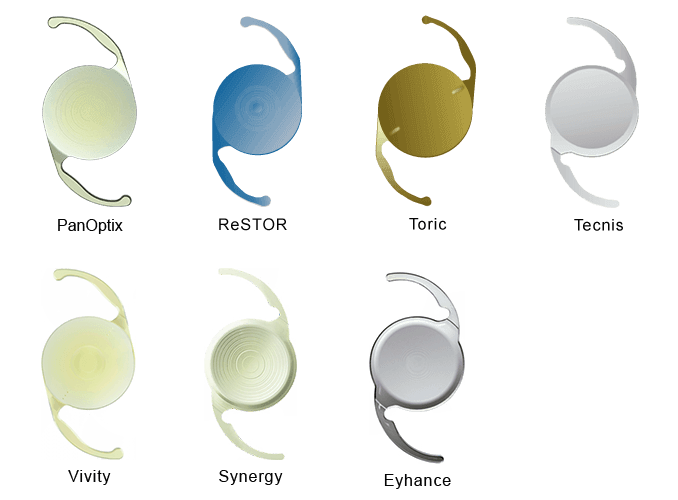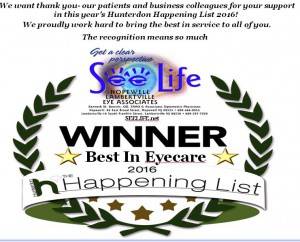Cataracts and Intraocular Lens Options
Other than the brain, the eyes are the most complex part of the human body. And while the complexity of the eye is necessary for its unique functionality, this same complexity means there are more possibilities for things to go wrong. It’s also why there are many different types of conditions and diseases that affect the eye. One of the most common eye conditions is cataracts. So, what is this condition and what can you do to protect your eyes?
WHAT IS CATARACT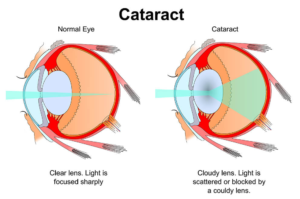
Inside of our eyes, we have a natural lens that bends incoming light, allowing us to see. In normal, unaffected eyes, that natural lens is clear. However, cataracts refer to a clouding of that clear lens of the human eye. Over time, this clouding affects eyesight, causing people who have them to have blurry, dull or double vision. If left untreated, cataracts can continue to develop, adding to worse side effects that may range from a loss of night vision to eventually complete blindness. The short answer is YES. As each of us gets older, we become more susceptible to cataracts.
CAUSES OF CATARACT
Age is the primary risk factor for their development. This is due to a gradual and natural change that occurs within the protein content of the eyes’ natural lenses, which begin to break down naturally in most people around the age of 40.
Although aging is the primary factor to developing cataracts, some individuals may be at an increased risk. Smoking, diabetes, genetic – or family – history and extensive exposure to UV rays all increase your chances of cataracts, and while most age-related cataracts develop slowly over time, ones that occur as a result of a genetic predisposition or environmental risk factors have a higher chance of cataracts forming more rapidly and impacting vision more dramatically, although each patient’s individual circumstances will determine how that particular case will progress.
INTRAOCULAR LENSES
Types of IOLs
There is a wide range of IOLs, including monofocal IOLs, multifocal IOLs, toric IOLs, and trifocal IOLs are available. These are all A designed to provide quality vision, thus enhancing your lifestyle and reduced dependence on glasses following the cataract surgery.
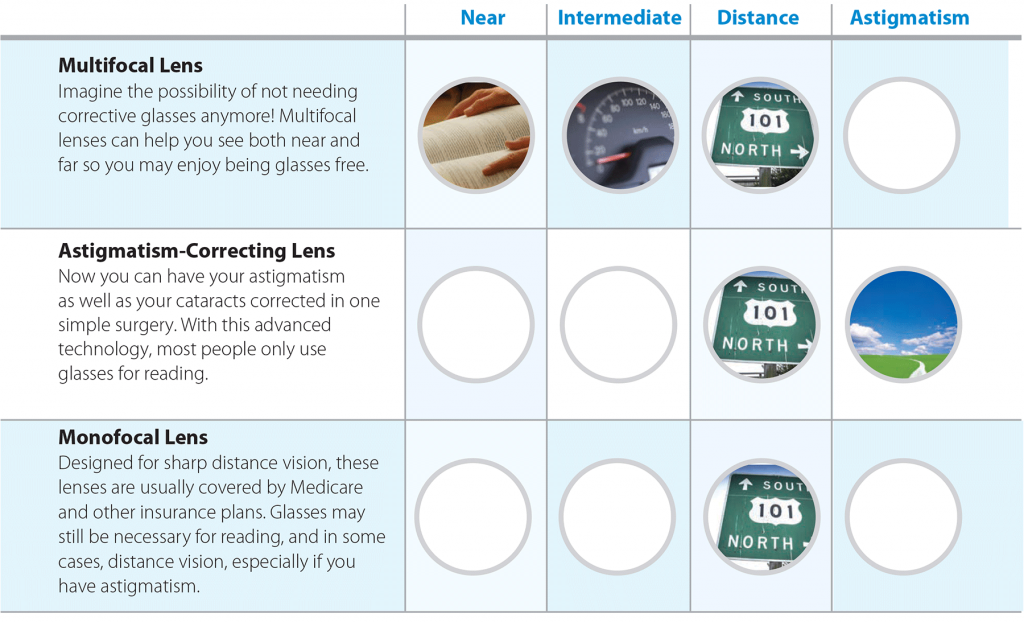

Lifestyle Lens Options
Hopewell Lambertville Eye Associates in conjunction with their consulting surgeons offer the latest technology in Lifestyle Lenses. The advances in intraocular lens (IOL) technology have made it possible to dramatically increase a patient’s ability to see after cataract surgery.
Previously, lens implants were only traditional, meaning that the lenses could only allow people to see at one distance, either near, intermediate, or far. With traditional lens implants cataract patients required glasses after surgery. Now, with premium lens implants like PanOptix®, Synergy, Tecnis® Multifocal IOL, and Acrysof® ReSTOR cataract patients are able to greatly reduce or even eliminate their dependence on glasses!
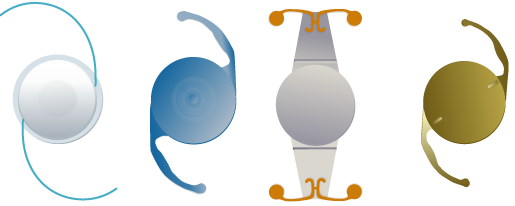
How do Multifocal IOL’s Work?
Our eyes are always adjusting and constantly focusing on objects up close, far away, and in between. The ability of our eyes to change focus from far away to up close is called accommodation. As we get older this ability decreases, and we become dependent on bifocals or reading glasses, this is called presbyopia. LifeStyle lens implants are designed to provide quality vision at a range of distances by combining the strengths of different technologies.
What is an Intraocular Lens?
An intraocular lens or IOL is usually implanted during cataract surgery to replace the clouded natural lens that is being removed. A comprehensive eye examination prior to surgery and discussion with your doctor will determine what type, size and power of IOL is needed. These lens implants are made from a flexible material and folded for insertion into the micro incision used to remove the cataract. Over the past several years there have been many advances in IOLs which have increased the number of lens choices available to patients. Your vision is achieved through a process of consultation with your eye surgeon to select the best lens to achieve your goals.
Standard LensFor more than 30 years, doctors have treated cataracts by replacing them with a conventional IOL, which allows you to focus clearly at one distance only. Typically, patients would choose to have the doctor aim for the best distance vision with the understanding that glasses would still be needed for close work, such as reading.
Premium LensIn recent years, however, IOLs have undergone tremendous advances. While your choice was previously limited to selecting a Standard IOL for one focal point, and using eye glasses for everything else; premium lenses can now provide good distance, intermediate and near vision. Our goal when using one of these premium IOL lenses is to provide you with a full range of vision, thus minimizing your dependence on glasses, including reading glasses or bifocals.
PREMIUM LENSES FALL INTO TWO CATEGORIES-MULTI-FOCAL OR ACCOMODATING
MULTI-FOCAL
Multi-focal lenses work by using various optical zones seen as rings on the surface of the lens. These optical zones have different powers which determine the focal point based on what you are looking at.
ACCOMODATING IOL
Accommodating lenses work by shifting the focal point on hinges to mimic the natural change of focusing power you enjoyed up until about age 40-50. As you get older you develop presbyopic vision which simply means that your eyes have lost the ability to shift a focus point. Reading glasses are commonly required so that you can see things up close. The accommodating lens is designed to allow you to change the focal point of the lens.
These lenses are not for everyone and some additional testing will need to be completed to determine if you are a good candidate for these premium lenses. The majority of patients who have chosen premium IOLs are absolutely amazed with the results and would recommend the procedure to their friends and family who have cataracts.
TORIC IOL
For patients with astigmatism who are having cataract surgery, you now have an additional option; an IOL that makes it possible to treat the cataract and correct your astigmatism at the same time. These IOLs are called Toric IOLs. Your doctor will recommend the option that is best for you.If you want to learn more about the life changing procedures involved in modern cataract surgery, we will be happy to answer all your questions. Although most insurance companies cover the cost for removal of your cataract, no insurance company will pay the additional amount charged for Toric, Multi-focal or Accommodative Lenses. If you are interested in any of these products or services, please understand that you will pay an additional fee per eye.
PanOptix® Trifocal Lens Implant
The Alcon PanOptix Trifocal Lens Implant is making headlines as the very first FDA approved trifocal lens implant for cataract surgery in the U.S. The PanOptix Lens reduces your need for glasses after surgery by correcting vision at all three distances opposed to only two of most multifocal lens implants. While this trifocal lens is new in the U.S., many trifocal lenses are widely used in Europe showing advances in a continuous range of vision. Dr. Brian Ranelle reports that the PanOptix lens excels in meeting patients needs. Dr. Jerry Hu and his colleagues published an article in the American Academy of Ophthalmology Journal comparing the patient visual outcome of a monofocal intraocular lens to the PanOptix trifocal intraocular lens. Learn more about the study and findings here.
With the PanOptix Trifocal Lens Implant, you can expect better image quality, enhanced middle and near vision as well as easier reading without glasses!
The Vivity IOL
The Vivity IOL is an extended depth of focus (EDOF) IOL. It stretches and shifts light entering your eye rather than splitting the light as a multifocal IOL does. Only the Vivity IOL can shift light like this, thanks to X-WAVE technology. This technology makes it so you can transition between distance and intermediate vision without night time rings or halos.
You can go from distance vision to looking at something close to your eyes without gaps in your vision or using glasses. You can see clearly at any distance with the Vivity IOL because of the quality vision it creates at each distance. It gives you monofocal-like distance vision, which means you will never need glasses or contacts to see over far distances. The intermediate vision Vivity provides is excellent, and the up-close vision is practical.
With the Vivity IOL, you should be able to read and use your cell phone without the need for glasses. You may need visual aids, though, if you are reading a food or prescription label.
Other than that, it can give you total visual freedom! If you want to reduce or end your need for glasses, the Vivity IOL may be right for you!
TECNIS Synergy Trifocal IOL
The TECNIS Synergy Trifocal IOL is one of the newest and highest-performing lenses on the market. It delivers the most comprehensive range of continuous vision among all IOLs and provides the best up-close vision of all multifocal IOLs. It combines extended depth of focus (EDOF) and multifocal technologies. EDOF technology creates a more extended focal point than a standard multifocal, increasing your vision range at each focal point.
The EDOF technology then gets combined with the best multifocal IOL technology. This combination creates multiple extended focal points which allows you to see clearly at various distances. It also eliminates visual gaps that other multifocal IOLs produce between refractive distances. Each focal point is longer than a standard focal point, which eliminates disruptions in your sight between refractive zones. Synergy technology also creates excellent contrast in your sight, in all lighting conditions. That means you can look at your cell phone or read in low light conditions without aberrations or glare. The Tecnis Synergy Trifocal lens also comes in a Toric model.
The TECNIS Synergy IOL also comes in a toric model, which means it corrects astigmatism. Whether you need the toric model or not, you can end your need for glasses with the Synergy IOL.
TECNIS Eyhance IOL
The TECNIS Eyhance IOL sets a new standard for monofocal IOL technology. Monofocal IOLs should deliver high-quality distance vision, and the Eyhance IOL does do that. But monofocal IOLs are also known for their inherent shortcomings. Besides only correcting one distance of vision, they also tend to have visual side-effects. Monofocal IOLs usually do not provide excellent vision at night and have trouble in other low-light, low-visibility situations. That’s different with the TECNIS Eyhance IOL. This new monofocal may provide better vision during less than optimal lighting conditions. It can make it safer for you to do things like drive at night.
If you’re considering a monofocal IOL for your cataract surgery, the TECNIS Eyhance IOL is the new standard for this technology. It handles varying light conditions better than any other standard IOL.
The Eyhance IOL also comes in a toric model. It corrects astigmatism and gives you high-quality vision in all light conditions.
Tecnis Symfony® Lens Implant
The groundbreaking Tecnis Symfony IOL represents the first and only Extended Depth of Focus (EDOF) IOL, a brand new category of presbyopia-correcting cataract lens, to receive full FDA approval in the United States. It provides patients a FULL RANGE of continuous high-quality vision while also minimizing the effects of presbyopia by helping patients focus near. Another unprecedented feature of the recent FDA approval includes a Toric version of the lens – the Tecnis Symfony Toric IOL – for patients with astigmatism.
In summary, the revolutionary Tecnis Symfony lens:
- Provides continuous, full-range vision. Patients can see objects clearly at near, intermediate and far away distances, and points in between.
- Yields high-quality vision. Patients with Symfony IOL report a high level of visual quality.
- Demonstrates “non-inferiority” in terms of halo and glare, day-and-night. FDA clinical trials show that patients with Symfony IOL notice no worse halo or glare as compared to standard monofocal IOLs in any lighting environment.
- Corrects astigmatism. Patients’ pre-existing astigmatism will be corrected by Symfony IOL without the need for additional surgeries on their corneas.
- Offers Extended Depth of Focus (EDOF). Patients benefit from a completely new category of presbyopia-correcting IOL technology
Tecnis Multifocal® Lens Implant
With the Tecnis Multifocal Lens, patients can experience vision at virtually all distances, even up close with little to no dependency on glasses. This works through the lens’ amazing ability to evenly distribute light between near and distance and performs regardless of pupil size or amount of light received.
The lens is designed to improve vision after cataract surgery and correct presbyopia, limiting the need for any reading glasses. The lens performed amazingly well for the majority of patients who had been implanted bilaterally in a recent FDA clinical study, with 96.4% reporting improved vision and the ability to see comfortably both near and far without glasses.
Alcon Acrysof Toric® Lens Implant For Astigmatism
 For many years, cataract patients who suffered from mild to severe astigmatism did not have a lens option to correct blurred vision after cataract removal. That all changed with the development of the Alcon Acrysof Toric® Lens Implant, which is able to actually correct astigmatism and provides improved visual acuity results.
For many years, cataract patients who suffered from mild to severe astigmatism did not have a lens option to correct blurred vision after cataract removal. That all changed with the development of the Alcon Acrysof Toric® Lens Implant, which is able to actually correct astigmatism and provides improved visual acuity results.
With the advancement in lens implant technology, even high levels of astigmatism can now be corrected during the cataract removal procedure. The Alcon Acrysof Toric® Lens Implant is astigmatism correcting, but may not correct both near and far vision, so reading glasses may still be required from time to time.
Toric Lens Implants are special astigmatism correcting Lifestyle Lens Implants. During cataract surgery, surgeons sometimes make limbal relaxing incisions (LRIs) in the eye to attempt to correct astigmatism. However, if a Toric Lens Implant is placed in the eye instead of a standard monofocal lens, then both the cataract and astigmatism can be corrected without any added surgical steps!
Choosing a Toric Lens does add a certain amount of out-of-pocket expense to the cost of cataract surgery, but Texas Eye and Laser Center offer a number of no-interest and low-interest financing options for our comprehensive eye care services to make the Toric Lens Implant affordable on any budget.
Alcon Acrysof Restor® Lens Implant
With the ReSTOR® lens, more than 97% of patients have reported being able to see distance (road signs) and near objects (newspaper, computer screen) with no difficulty. The ReSTOR® lens is not dependent on the muscles or the mechanics of the eye to provide a clear vision and is able to deliver consistent results by acting as two lenses in one. This is the lens for patients who wish to reduce or eliminate glasses, even for reading, after cataract surgery.
It is important to select the right lifestyle lens implant to meet your specific vision needs. One of our experienced Hopewell Lambertville Eye doctors and surgeons will discuss the premium lens options available.
If you have any questions, please email or call us at Hopewell Eye 609-466-0055 or Lambertville Eye 609-397-7020. www.seelife.net
